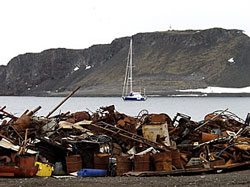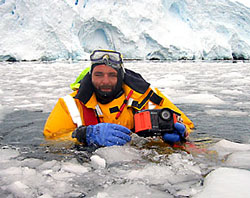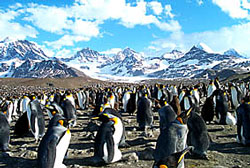The capital Port Moresby has a fairly poor reputation,
in part deserved, but then, all large cities have their
problems. Having said this, Port Moresby is not a large
city, it is hard to really say where the centre is, as it
is small-ish but sprawling. There is a down town of a type
where there are a few multi storey buildings, including the
infamous Deloittes building. Last year when I was there, I
read a newspaper account that said that this building had
been built three times. The first two times, the
construction was awarded to a firm who took the money and
went bust. The final time, at hugely escalated costs, it
was finally built and houses the few accountancy firms that
remain in Port Moresby and other businesses. Shell have
offices around the corner.
This starts to highlight the real problem with PNG as a
whole: crime, environmental degradation, corruption and
cronyism. There is a system called won tok, whereby your
won toks do you a favour, such as getting you a job, and
this holds you in their debt and you are expected to do
favours for them. For example, if someone wrongs you or
your family, you can call on your won toks to right the
wrong.
And this brings me to discuss law and order. The
population of PNG is 4 million, and there are around 400
police officers. The geography of the area is interesting.
On the other half of New Guinea that is PNG, as opposed to
Indonesian, there is a large mountain range separating the
north from the south. There are no roads that connect the
two coasts. The interior is very mountainous and remote.
There are a collection of outlying islands, including New
Britain, New Ireland, Bougainville and many smaller
islands. This geographical dispersion and the remote
interior has resulted in many different tribes of people
and over 700 languages.
Many people from the highlands and islands, unable to
make ends meet, or ambitious for a better life migrate to
the cities, such as Port Moresby, Lae, Kavieng seeking
work. These people are referred to as settlers, and they
build their own houses from wood, corrugated iron, palm
leaves, plastic bags or sheeting etc and maybe cultivate a
little land by growing mangoes or coconuts etc. In Port
Moresby, there are many settlements which an outsider
cannot and should not go into. The nearest comparison I can
think of are the shanty towns in Rio or the townships
around Johannesburg. They are self policing or completely
lawless, depending on which way you look at it.
Over Christmas 2003, I was in Madang, a very pretty
natural harbour town on the “main” land. The
government had previously issued several warnings to the
settlers there that they should leave and go back to their
original home land. Few settlers did leave. Over Christmas
it became real, and the police were deployed to forcibly
evict the settlers from their homes, by burning down their
houses and chopping any cultivated trees down. It was a sad
sight. There were reports that the police were stealing
possessions from inside people’s homes before they set fire
to them. In Madang, many of the settlers had been there for
over 20 years, and the mood of the people I spoke to was
that the government should have laid on some transport or
means of helping people to return to their original
homeland. I since read a newspaper report that said that
the PNG government had refused to allow the Red Cross to
distribute aid to the displaced settlers. It was not a good
time and I imagine is still on going. I know this happened
in provinces other than Madang.
There is a small ex-pat population in Port Moresby and
they live in compounds. I visited the Shell compound, and
was quite taken aback by the security: double gates to get
into the compound, razor wire all around, watch towers,
guards and guard dogs, electric fences and inside each of
the 6 homes, huge sturdy rape gates on the top floor to
prevent entry into the bedrooms.
The majority of expats are Australian and this is the
closest sizeable country. Many companies have pulled out of
PNG as they say it is too difficult to do business there –
problems with land title, bribery and corruption and high
levels of crime.
The Australian High Commission sits on a hill and the
houses for their staff are right beside it, and look like
Lego buildings. Locals call this compound “Shit
Scared Alley”. I spoke to some of the Australian High
Commission staff and they said that they barely leave the
compound. Car-jacking is common place, rape, sexual abuse
and incest are distressingly too common. All men own
machetes. There did not seem to be too much of a gun
culture, but they certainly exist. AIDS is not a huge
problem yet, but it is there. The female expats, mostly
wives of ex-pat workers are advised to be extremely careful
where they drive and not to fill up at petrol stations
alone for fear of being car-jacked. The modus operandi is
to rape a woman in front of her husband or son and make
them watch. This was every ex-pat woman’s biggest
fear and I sensed a huge feeling of vulnerability.
This probably paints a fairly grim picture of Port
Moresby, but it is at least realistic. I stayed there a
week by myself in Christmas of 2002. I stayed at the Magila
Hotel which was cheap, friendly, clean and safe. It was a
fairly transient sort of place, and not in a good part of
town, being in Six Mile – called Six Mile because it is 6
miles from the centre. The motel is surrounded by razor
barbed wire and has a watch tower and 24 hour guards –
common for Port Moresby. I did not go outside the motel at
night on foot – you really don’t walk anywhere in Port
Moresby, but I did go by car with friends I made, into town
and had meals there etc.
Everyone I met was friendly, polite, interested in why I
was in PNG and I have never encountered any problems
myself. The diving in Port Moresby is excellent and there
are 2 dive facilities – PNG Dive, where I was, and a
resort, the Loloata resort. There are 2 places where
ex-pats go: the Yacht Club, with good views, a cheap bar
and decent food, but predominantly frequented by ex-pats,
and there is another place where ex-pats married to local
women tend to go. Rather uncharitably, a friend of mine
said you could always tell who would go there because they
have a red nose through drinking too much.
There isn’t a huge amount to do in Port Moresby and I
would not recommend it to the visitor other than to dive.
There is an interesting designed Houses of Parliament, and
my favourite place is PNG Arts. It is a large shop that
sells handicrafts made by people from all over PNG, from
the river Sepik where the work depicts spirits in the form
of crocodiles, from the islands and from the highlands. I
love it there and have spent many an afternoon browsing
around the masks, ceremonial daggers, tables, wooden
crocodiles and yes, they do make penis gourd holders – the
shop told me that the Japanese are the largest customers of
these! The people who work there are great (especially Ken,
the Canadian who went to PNG as a bet in the 1960s) and the
man who owns it is local. They can tell you who made the
artefact you are interested in and can ship direct to your
home country. I did this last year and had 2 crates sent
back to London – it took 5 months to arrive, but it did
arrive!
Infrastructure in Port Moresby is better than it used to
be. Many of the roads have been repaired – in December 2002
when I was first there, there were huge craters throughout
all of the roads which created small mini roads around
them! Taxis are very expensive and you need to make sure
that the driver knows exactly where you want to go.
Electricity is mostly on although the water is not safe to
drink from the tap, bottled water is widely available. If
you need to stay over in transit, the Airways hotel is
pretty good, and you can get a free transfer from both the
domestic and international airport as they meet every
flight, even if you don’t stay and just want to have lunch
or dinner there or sit by the pool. It has a nice green
setting, overlooking the airport, 5 minutes drive away on a
hill and they do good food.
Bride price is still paid by many people. One man I met
who helped with the dive operation I was at last year told
me how much he paid in bride price for his wife. It seemed
like an awful lot (won toks are expected to chip in as well
as the entire family) and I said jokingly that his wife
must be a princess. He solemnly replied that yes, she was a
princess.
Once you get outside Port Moresby then you can then
appreciate the true beauty of the country and the
friendliness of its people.

 In 1992 Robert was the keynote speaker at the
first Earth Summit in Rio and spoke about the rubbish
problem in Antarctica. With their approval he then set up a
project to do something about it, choosing the Russian Base
of Bellingshausen, as it was one of the worse areas. Also,
it was accessible to visiting ships and had a runway
nearby, allowing both easy access for research into the
removal and aiding the difficult logistics.
In 1992 Robert was the keynote speaker at the
first Earth Summit in Rio and spoke about the rubbish
problem in Antarctica. With their approval he then set up a
project to do something about it, choosing the Russian Base
of Bellingshausen, as it was one of the worse areas. Also,
it was accessible to visiting ships and had a runway
nearby, allowing both easy access for research into the
removal and aiding the difficult logistics.
 South Georgia is truly one of the world’s
most spectacular wildlife habitats. This is mostly due to
its desolation and the fact that man finds it so very hard
to reach it – even in this day and age.
South Georgia is truly one of the world’s
most spectacular wildlife habitats. This is mostly due to
its desolation and the fact that man finds it so very hard
to reach it – even in this day and age.